ALEXANDRIA, Va. – Interconnectivity is foundational to modern communications networks. It is the “inter” in internet. It underpins modern mobile networks. Yet, today’s space networks still lack fundamental interconnectivity. Broadband constellations don’t talk to one another. Users of one constellation can’t “roam” between satellite network service providers. And performance metrics can often be opaque.
A team of university researchers is working to change that with a networking infrastructure that seeks to foster the development of secure, transparent connectivity between various space networks.
 Researchers at Virginia Tech, George Mason University and the University of Surrey have teamed to develop distributed, mobile space and terrestrial networking infrastructure for multi-constellation coexistence. (Source: Virginia Tech and Mohamed Kassem, University of Surrey)
Researchers at Virginia Tech, George Mason University and the University of Surrey have teamed to develop distributed, mobile space and terrestrial networking infrastructure for multi-constellation coexistence. (Source: Virginia Tech and Mohamed Kassem, University of Surrey)
“We wanted something like a terrestrial wireless environment where everything is connected to everything else seamlessly and the network backhaul is transparent to the individual users,” said Jonathan Black, principal investigator and professor of Aerospace and Ocean Engineering at Virginia Tech’s College of Engineering.
Black and his colleagues were recently awarded a $2 million National Science Foundation grant to develop the concept through a project called SpaceNet. SpaceNet is a hardware-in-the-loop, multi-site testbed that will support the research needed to evaluate and enable interconnected satellite networks that more closely resemble an open internet architecture—or as Black described it: “The internet of space things.”
“In the internet-of-things model, any individual thing can connect to any other individual thing, as long as it’s on the internet,” Black said.
Today, that model is Earth-bound and the result of (sometimes painstaking) agreements among competing internet service providers and mobile network operators. The incorporation of satellites into the 5G ecosystem as well as the rollout of satellite direct-to-device applications are making it possible to achieve ubiquitous connectivity between anything, almost anywhere—from Earth’s surface to LEO and GEO and even cislunar space.
“If you wanted to treat UAVs or high-altitude [platforms] or satellites or undersea vehicles as nodes on a network, they would have to be able to connect to any network and not be specific to just one,” Black explained. “The goal is…to make the networking piece easier or more transparent to the individual user equipment or devices that are on the networks.”
A Resource for the Space Network Communities
The SpaceNet testbed will emulate the changing connectivity environments of various broadband satellite constellations. As a research resource, it will benefit “the overall wireless engineering and space network communities” as well as academia, according to Black.
When completed, the testbed will actually encompass multiple testbeds at Virginia Tech, George Mason University and the University of Surrey that will be networked together and remotely accessible. As the project develops, there will be opportunities to network additional testbeds, as well. The connected research environment will be “flexible enough that it can look like as many of the different constellations and networks as possible and test as wide a range of different scenarios as possible,” Black noted.
 Students at Virginia Tech work on the hardware-in-the-loop test bed that emulates the changing connectivity of a mega-constellation at scale. (Source: Jama Green, Virginia Tech)
Students at Virginia Tech work on the hardware-in-the-loop test bed that emulates the changing connectivity of a mega-constellation at scale. (Source: Jama Green, Virginia Tech)
One of the first challenges in getting the project off the ground was replicating the closed, proprietary networks—like Starlink, OneWeb, Iridium, etc.—in the test infrastructure. Part of that solution involved researchers at the University of Surrey and other institutions gathering network performance data from various users across Europe and the United States. Different variables and external performance data fed the development of standard metrics, which became a baseline for testbed users to compare implementations and instantiations.
“Right now, you sort of have to build an entire constellation and launch it before you really get any feedback into the level of competitiveness or how your system is going to be innovative with respect to some of the other ones,” Black noted.
Having the research infrastructure will hopefully allow for more benchmarking and “more rapid incorporation of new technology into the overall market sector.” In addition, testbed users will have greater transparency into the most optimal network or network configurations for particular use cases and how they can be further optimized for power, security, latency, data rate or other needs.
There is also a cybersecurity component to the research architecture that is focused on network resiliency. Black explained that the testbed will combine physical and virtual nodes that can be turned on and off to simulate a cyberattack, onboard failure or other malfunctions. Testbed users will be able to use the environment to observe and improve network performance in response to degradation and disruptions.
A New Field of Networking?
While work is steadily progressing, Black anticipates the team’s biggest near-term hurdle will be scalability.
With support from the Commonwealth Cyber Initiative (CCI), researchers at Virginia Tech have already conducted initial studies simulating point-to-point connections among several hundred ground users, several thousand spacecraft and various connected devices.
The computations were challenging under the limited test scenarios. Black anticipates they will become unwieldy when they expand the architecture to millions of users on the ground and tens of thousands of nodes in space.
In their initial studies, Black’s team found that the network routing tables were being updated every 10 seconds as satellites moved relative to each other and relative to the ground. Expanding that framework to a larger mesh creates an overwhelming problem for precomputing routing tables—let alone network optimization or real-time reconfiguration and adaption. It becomes “a scalability problem for how we’re currently doing network calculations,” Black emphasized.
“But standby,” he continued. “It might be a whole new field of networking we need to come up with!”
An Open Source Community
A significant part of the SpaceNet project is an emphasis on building a community around its open source software infrastructure. Project leaders will make the code available on a Git repo, allowing developers to set up their own testbeds, develop capabilities and contribute those back to SpaceNet via virtual access points.
Black wants more researchers, developers and companies to be involved with the testbed by contributing their hard problems and solutions, designing scenarios, expanding testbed capabilities and using the software environment to test and even transition new technologies.
Virginia Tech students are already beginning work on the project this summer through a collaboration between Space@VT, Wireless@VT and CCI, Black said. “It’s a nice mix of the applied, hands-on experiential education for the undergraduates, where the graduate students are able to take ownership of the capability that they’re bringing to the overall system.”
A few companies have also gotten involved in the development of the testbed. An international workshop last summer brought together academics, industry and several government funding agencies to share hard problems and capabilities, and to collaborate on solutions. Researchers are planning another workshop in the next year that will feature the initial release of the testbed and code.
Currently, SpaceNet is working on a three-year timeline in which project leaders plan to develop and advance the testbed’s capabilities and build a self-sustaining community of users and contributors by the time the final project is released.
Explore More:
University Spotlight: How an Experimental GPS Receiver is Changing Electronic Warfare
University Spotlight: A Systems Engineering Approach for Emerging Space Actors
University Spotlight: Enabling SmallSat Autonomy Through Onboard Fault Detection
Podcast: Antenna Technology, Exponential Growth and Adapting to the ‘Multis’
